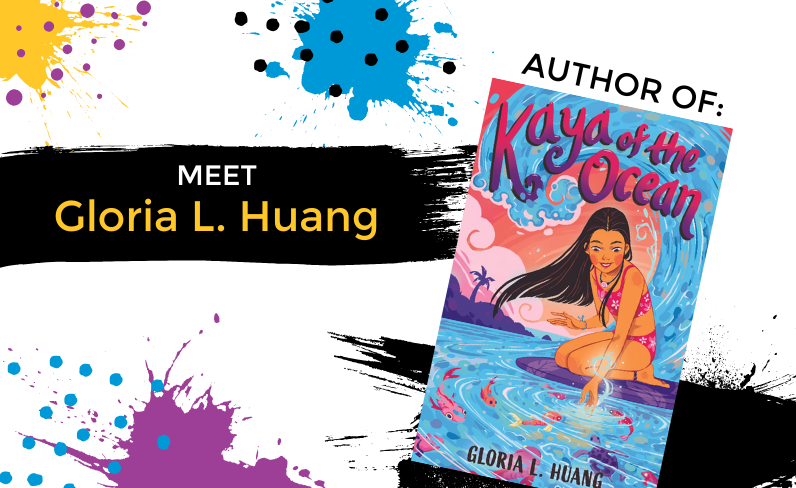This month’s Ink Splat Author Interview features Gloria L. Huang, author of Kaya of the Ocean.
In our interview, Gloria shares the moment when her novel idea arrived, strategies for dreaming up stories and getting unstuck, and how to lean into the heart of your story, letting your writerly voice and perspective come through in the work you create.
You can learn more about Gloria and her work here: glorialaihuang.com

Writing Challenge
Time-Traveling: Meeting a Character Through their Family Story
In her interview, Gloria speaks eloquently about how a character’s family and history contributes to who they are and how they engage with the world.
Try this: Start with a family story of your own, one you know well. Maybe you have a specific holiday tradition or a family story that has been passed down through generations. Consider that timeline and the people’s lives it might have touched as it traveled through time. What character might you enjoy creating who is somehow connected to that history? Would you want to make a present-day character, or someone who was part of the story at its beginning?
Take your idea and build a character. Consider not only your character’s age, interests, skills, and weaknesses, but also their family and community. How might the people in their lives contribute to their story? Write a short scene featuring your character. It doesn’t have to be a full story, just a moment in time that shows your character in action.
Play with the possibilities and if you end up with a story you’d like to share, we hope you will! Did you know that as an Inklings member, you can submit your creative writing on our Inkwell app to share with an audience of enthusiastic readers? You can ask for revision feedback on a work in progress, or submit a finished piece and hear back from readers about what they loved.
Join us and share your writing on the Inkwell!

What inspired you to write Kaya of the Ocean?
I came up with the idea for Kaya of the Ocean when the world was first emerging from the pandemic. A child very close to me was struggling with anxiety for the first time, and watching the struggle reminded me how scary and painful it can be. How, especially when you’ve never experienced anxiety before, you often feel like something’s wrong with you.
I was standing by the ocean at night, and I was thinking about how the ocean can be so many things: powerful, calm, dangerous, wild, gentle, strong. I decided I wanted to write a story about a girl struggling with anxiety who discovers she has powers over the water, but she’s not in control of those powers. I wanted to write about her journey to accepting all parts of herself, even the parts she may not love and may see as flaws or weaknesses. I wanted to send a message to these brave children fighting battles deep inside where no one can see, and let them know there’s beauty and strength in accepting their whole selves.
Kaya’s story weaves together history, myth, and family. At Society of Young Inklings, we’re talking about character development and I wonder whether you can speak to how these factors – history, myth, and family, contribute to who a character is now and who a character is becoming?
It’s almost impossible for me to separate a character’s history and family from who they are and their journey to who they become, because I see those elements as being so crucial to a person’s essence. When I first imagine a character, I also imagine their family and their history, and how they shaped and continue to shape them. Sometimes I write character sheets where I tease out all the people and events in a character’s present and past.
I often weave myth into my books, as I see mythology to be the connecting thread between history and family. It’s the stories a group of people tell about their past and the links between the people and events that make up their culture and community. All of these elements contribute to the nuances and complexities that make up a person, fictional or real.
The novel shines a light on growing up and feeling different. How did you tap into these resonant themes when developing Kaya’s character?
It was pretty easy because these were key themes I’ve lived with in my own childhood and youth. As a child of immigrants, I often struggled with feelings of isolation and non-belonging. I would read and write to escape from these feelings, with varying levels of success (because books at that time did not always contain diverse characters, so sometimes I faced the same issue of non-belonging in fictional stories where no one looked like me or my family). As I grew as a writer, the experience of growing up and feeling different naturally made its way into much of my writing, both because it’s what I know and because I want to make sure any child going through a similar experience sees themselves reflected in books and knows they’re not alone.
What was your favorite scene to write, and why?
There’s a scene towards the end of the book when Kaya rides her bike to the ocean at night. She’s terrified and angry and flooded with guilt over accidentally hurting someone she loves. The moment she stands at the water’s edge, broken and on the brink of so many discoveries, was such an important moment. She’s right on the cusp of understanding something important about herself, but she has to go through so much pain to get there. I knew it was an important scene, and a complicated one to write in terms of balancing all the feelings and the eventual reveal. I’m pretty proud of how it turned out.
How do you balance fantastical elements with real-life struggles?
This is actually my favorite genre to write (contemporary fiction with elements of fantasy), and I think part of the reason is because I feel that fantastical elements are the perfect metaphor for real-life struggles. Or maybe it’s that I process real-life struggles best in the context of fantasy? Either way, my stories often develop very organically where my characters are facing real-life struggles and fantastical struggles at the same time. In Kaya of the Ocean, for example, I imagined the character of Kaya and her anxiety while gazing out at the ocean and marveling at the power and vulnerability of the water. The fantastical component of the story unfolded quite naturally from that point. (As an aside, I try to be careful not to describe a book like Kaya as a “fantasy novel”, as I know that sets certain expectations about the level of fantasy involved. In my books, the fantastical elements are very much counterbalanced with real-life struggles.)
When you’re feeling stuck in your writing, what helps you keep going?
There’s a couple things I turn to when I encounter the dreaded “writer’s block”. First, if I’m really spinning my wheels, I often take a step back and “refill the creative well” by consuming art not created by me: reading books, watching movies, etc. Then, after a break during which I’ve hopefully refreshed my mind, I’ll return to my writing and force myself to write a “bridge” to the next passage. When I write my “bridge”, I force myself to put down words even if I can tell they’re coming out wrong. I reassure myself I can revise them during the editing phase, and sometimes they become something unexpectedly beautiful. One thing I’ve noticed about writers is that we’re “word perfectionists”— we dislike writing even a single word that isn’t the exact perfect word, but that often creates obstacles for ourselves. Giving yourself the permission to be imperfect can be surprisingly freeing.
If Kaya herself could give advice to young writers, what do you think she would say?
Kaya’s main piece of advice would be to give yourself permission to be imperfect. Kaya understands, so much, how it feels to struggle with the pressure to be perfect, and she knows how fear and self-doubt can hold you back. Writers often want every sentence, every word to be perfect, and that can be hard when you’re creating a story or a book. Kaya would tell them to remember there’s beauty in imperfection, and to have the courage to write imperfectly. She would remind them that writing, like any human being, is a messy work in progress!
What’s next for you—are there more stories featuring Kaya, or something brand new?
No more stories featuring Kaya yet, but I did write the ending a little open-ended with the thought that maybe in the future, I could explore more of Kaya’s journey. I have another book (unrelated to Kaya) that was acquired and will be published in 2027. It hasn’t officially been announced yet, but it will be soon (hopefully), and I can share more details then!



